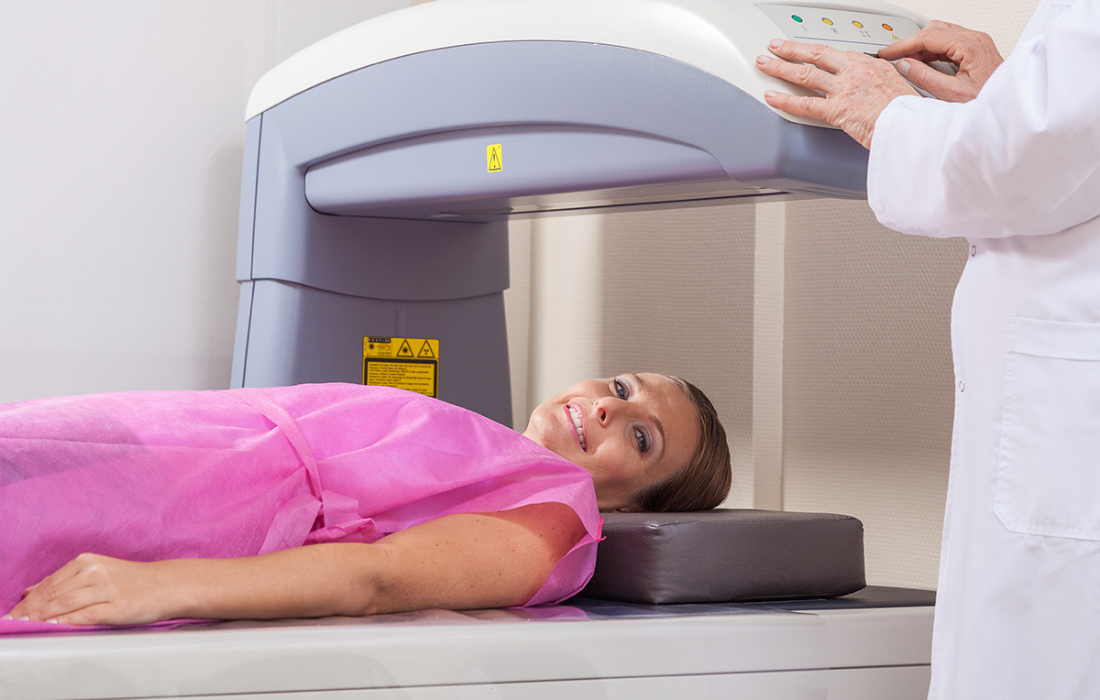Getting the Facts on DXA

Years ago most people assumed that once you got older, you had to cope with the aging disease of osteoporosis or bone thinning. It was thought that fragile bones and a humped back were signs of aging and were inevitable. Today we have both the technology to assess for thin bones and we have approved and efficacious treatments available to treat osteoporosis. The best bone test is dual-energy X-ray absorptiometry (DXA or DEXA).
What is a DXA Scan?
DXA measures a bone’s mineral content. It is a fast and painless test with very low radiation doses and it is considered the gold standard to assess bone mineral density (BMD). The standard procedure, central DXA, measures the lower spine, hip and narrowest part of the hip bone, also known as the femoral neck.
What is DXA used for?
DXA is used to predict the risk of fracture, since low BMD explains about 50 to 70 percent of fracture risk. Results of central DXA testing can give an accurate estimate of how likely you are to sustain a fracture of the hip or spine—the most common sites—or elsewhere in the body. DXA can also be used to monitor the effectiveness of medicine to treat low bone density (osteopenia) or diagnosed osteoporosis.
Who should be screened with a DXA scan?
The National Osteoporosis Foundation recommends that the average-risk women be screened at age 65 and men by age 70. Many factors can hasten bone loss in both women and men and earlier testing is advisable in a number of instances.
- Early menopause before the age of 50—loss of estrogen speeds up mineral bone loss promoting brittle bones and increased fracture risk
- Excessive alcohol consumption
- Low body weight
- Medical conditions associated with low bone density, such as diabetes, rheumatoid arthritis, inflammatory bowel disease, celiac disease and neurologic disorders like stroke or Parkinson’s disease
- Smoking
- Use of certain medications, such as corticosteroids (prednisone), some prostate and breast cancer medications and seizure medications
DXA screening is recommended when a fracture occurs for any reason in patients 50 or older. Height loss of 2 inches or more may indicate a spinal fracture and may warrant a DXA screening.
What is involved with DXA scan?
Patients are fully clothed and lay on their back while the scanner performs the scan over your spine, hip and femoral neck. The actual scan takes no longer than eight minutes and results are available immediately.
In preparation for the scan, patients should:
- Avoid taking calcium supplements for a minimum of 24 hours prior to the exam
- Wear loose, comfortable clothing, taking care to avoid wearing anything with a zipper, belt or buttons that are made of metal
- Inform the technician if they have recently had a test done using barium or an injected contrast material
How does UOA use DXA?
At University Orthopaedic Associates (UOA), our GE Lunar Prodigy DXA machine is an integral part of our Bone Health Program at our comprehensive Bone Health Center. Created and managed by clinician Patricia Seuffert, MS, APN, CCD —who was awarded recognition from the state of New Jersey as a bone champion for her work in developing a fracture liaison service —the program is designed to provide the best possible care for patients with osteoporosis and other bone loss conditions. In short, UOA is your first step to stronger, healthier bones.
For more information about DXA or to schedule an appointment with one of our specialists to discuss your bone-related issues, contact us today.

